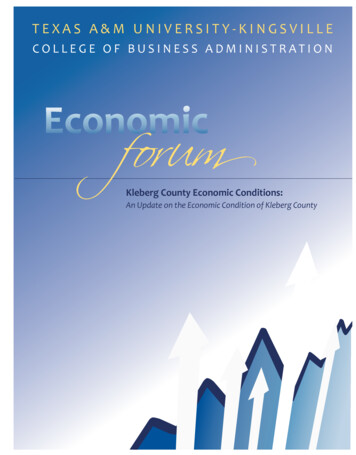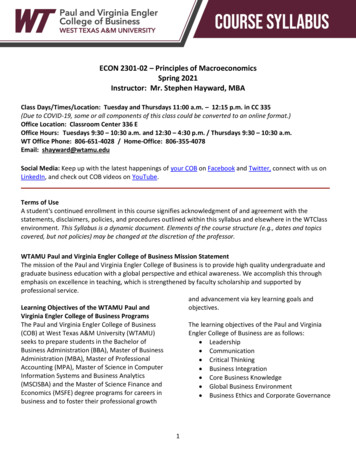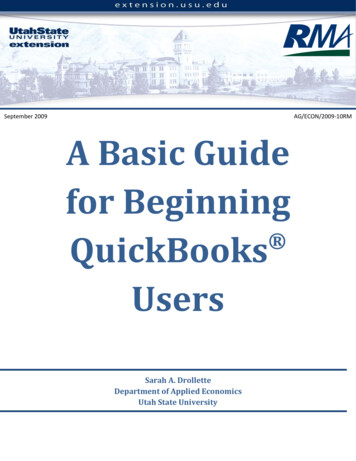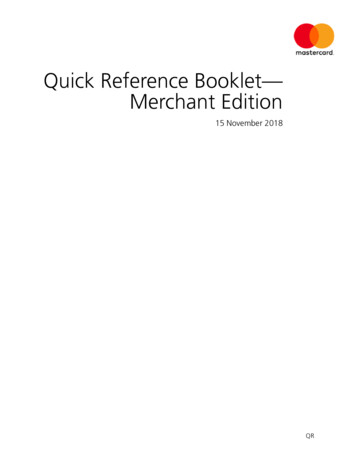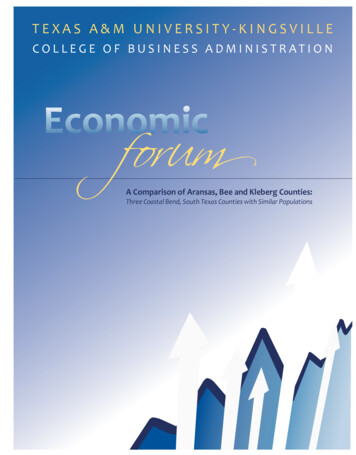
Transcription
TEXAS A&M UNIVERSITY-KINGSVILLECOLLEGE OF BUSINESS ADMINISTRATIONforumA Comparison of Aransas, Bee and Kleberg Counties:Three Coastal Bend, South Texas Counties with Similar Populations
PresentersTheDr. Keith R. Phillips–Senior Economic and Policy Advisor at the Federal Reserve Bank of DallasSan Antonio Branch“An Overview of the Texas Economy”Dr. Phillips joined the Federal Reserve Bank of Dallas in January 1984. His areas ofconcentration include regional economics and economic forecasting. Dr. Phillips haspublished numerous articles on the economy and other economic topics in Dallas Fedpublications and academic journals. Research Papers in Economics, which tracks publications in economics, ranks Phillips in the top five percent of economists across the worldin terms of the number of distinct publications. He is a contributing member of theWestern Blue Chip Economic Forecasting Group, where he has been the most accurate out of eight Texas forecasters fornine out of the past 16 years. His research and analysis has been covered in media such as CNN, The News Hour with JimLehrer, USA Today, Business Week, the Wall Street Journal, The New York Times, MSNBC and in media throughout Texas.In August, 1996, Dr. Phillips was transferred to the San Antonio branch in an effort to improve the regional economiccoverage of the Dallas office and to better serve the needs of the South Texas community. Dr. Phillips teaches courses inmanagerial economics and quantitative analysis in the Executive MBA program at UTSA. He obtained his Ph.D. ineconomics from Southern Methodist University and holds a B.A. and M.A. in Economics and a Bachelor of Journalismdegree in News/Editorial from the University of Missouri at Columbia.Dr. Thomas Krueger–Professor atTexas A&M University-Kingsville College of Business Administration“A Comparison of Aransas, Bee and Kleberg Counties:Three Coastal Bend, South Texas Counties with Similar Populations”Dr. Thomas Krueger is a professor in the Department of Accounting and Finance at TexasA&M University-Kingsville. He holds a DBA in Finance from the University of Kentucky, anMBA from Minnesota State University and a B.S. from University of Wisconsin-Eau Claire.Before joining Texas A&M-Kingsville, he taught finance at the University of NorthCarolina at Charlotte (1986-1989) and the University of Wisconsin-La Crosse (1989-2010). While at UW-La Crosse, he waschair of the Finance Department from 1993-1999 and Internship Coordinator for the East Central European ScholarshipProgram, finding and directing the internship experience for 450 mid-level and higher managers from Eastern Europe. In2010, Dr. Krueger taught Investments to members of the U.S. Army at the Fort McCoy installation.Professor Krueger teaches multiple undergraduate and graduate finance classes. Finance classes taught during the pastyear include, Financial Planning and Capital Budgeting, Financial Ranch Management, Global Finance and PortfolioManagement. He has authored over 65 refereed journal publications, including original rigorous research leading to theidentification of the famous “Super Bowl Stock Market Predictor.” His research has been found in such renownedpublications as the Journal of Finance, Journal of Accounting and Finance, and Journal of Investing. Since joining Texas A&MKingsville in 2011, he has won a “Best in Track Award: Investments and Portfolio Management” for his presentation of hisstudy of Consumer Reports’ mutual fund selection and a “Distinguished Research Award” for his study of the academicjournal review process. Today is his third annual presentation regarding regional economic conditions.
Vincent J. Capell, CPA, CGMA–City Manager, Kingsville, Texas“A Response Regarding How the Data from Last Year’sPresentation Was Used to Improve the Region”Mr. Capell attended Idaho State University in Pocatello, Idaho graduating in 1977 withdual degrees in Finance and Accounting. Mr. Capell earned his CPA license in California in1981 and is currently licensed in Missouri and Texas. Vince’s private sector work experience includes 13 years in the San Francisco Bay Area where he worked for a subsidiary ofTransamerica Corporation and the International Accounting Firm Ernst & Whinney, CPA’s (now Ernst & Young). Vince’spublic accounting career includes serving clients in the financial services, trucking, leasing, construction and high-techstorage device manufacturing industries.In 1990 Vince and his wife moved their young family to his wife’s hometown of St. Joseph, Missouri where he began hispublic sector career. Vince served the City of St. Joseph for 21 years in various financial and administrative capacitiesincluding nine years as City Manager before retiring in March 2011. Mr. Capell is on record as being St. Joseph’s longestserving City Manager. During Vince’s tenure, he worked with other community leaders on numerous successful economicdevelopment and community building projects including, most recently, assisting with the local financing package neededto recruit the Kansas City Chiefs’ summer training camp to St. Joseph’s Missouri Western State University.Mr. Capell continues his public sector career with the City of Kingsville where he began his employment in April 2011. Vinceenjoys working with Mayor Fugate and the City Commission and with other community leaders in an effort to makeKingsville all that it can be.
forum& LuncheonSponsored by Kleberg BankTuesday, February 18, 2014, 11:30 a.m. - 1:30 p.m.Memorial Student Union Building Ballrooms A&BLunch . 11:30 - 11:55 a.m.Welcome and Introductions by Dr. Natalya Delcoure, Dean,Texas A&M University-Kingsville College of Business Administration . 11:55 a.m. - 12:00 p.m.Welcome from by Mr. Joe Henkel, President and CEO, Kleberg Bank.12:00 - 12:05 p.m.“Overview of Texas Economy” by Dr. Keith Phillips, Federal Reserve Bank . 12:05 - 12:30 p.m.“A Comparison of Aransas, Bee and Kleberg Counties” by Dr. Thomas Krueger,Professor, Texas A&M-Kingsville . 12:30 - 12:55 p.m.“Response Regarding How the Data from Last Year’s Presentation Was Usedto Improve the Region” by Mr. Vincent Capell, City Manager, Kingsville, Texas . 12:55 - 1:20 p.m.Question & Answer Session . 1:20 - 1:25 p.m.Concluding Remarks by Dr. Delcoure . 1:25 - 1:30 p.m.Featured Speakers:Dr. Keith R. Phillips–Senior Economic and Policy Advisor at the Federal Reserve Bank of Dallas- San Antonio Branch“An Overview of the Texas Economy”Dr. Thomas Krueger–Professor at Texas A&M University-Kingsville College of Business Administration“A Comparison of Aransas, Bee and Kleberg Counties:Three Coastal Bend, South Texas Counties with Similar Populations”Mr. Vincent Capell, CPA, CGMA –City Manager, Kingsville, Texas“A Response Regarding How the Data from Last Year’sPresentation Was Used to Improve the Region”
PurposeStatement ofThis report provides comprehensive documentation concerning regional economic indicators for KlebergCounty, Texas. The research is an ongoing analysis provided by the Texas A&M University-Kingsville College ofBusiness Administration. The first section presents a broad range of socio-demographic data, while thesecond reveals economic performance. For instance, Section I includes information about poverty levels,education levels and sources of income in Kleberg County. Special attention is paid to the government sectorwithin the local economy. Section III presents opinions regarding key economic factors expressed by localbusiness leaders and students. This project builds on the base of economic information provided first in 2012,and is expected to annually expand our understanding of Kleberg County providing decision makers with avaluable tool for strategic planning.Kleberg Bank sponsors this research in collaboration with the Texas A&M University-Kingsville College ofBusiness Administration. Mr. Dick Messbarger (Economic Development Council) and Mr. Vince Capell (City ofKingsville) have provided input on the project since its inception. In addition, I want to thank Ms. Mary AliceWiechman and Mr. Harmeet Singh from the College of Business Administration.Specific goals of this project include: Support business owners in their decisions by gathering key indicators of local economic vitality. Identify trends in order to ascertain the current situation in the dynamic nature of the economiccondition. Develop specific economic indicators for the region that are not readily available to decision makers. Act as a storehouse of these fundamental and trend insights. Develop tools to assess Kleberg County’s economic progress. At the outset, baseline measures are beingdeveloped that will allow comparison with other regions and measure future economic growth of theeconomy. Only by knowing one’s current condition is it possible to gain an understanding regardingwhat the future holds. Bring academic and governmental professionals together with business owners for discussion about thelocal economy and related critical issues. Create a business recruitment and retention tool by publishing this information.The 2013 ReportIn 2012, the College of Business Administration hosted the first Economic Forum. As part of that event, acomparison was made between Kleberg County, adjacent Brooks County and Jim Webb County and the stateof Texas. In 2013, current economic conditions in Kleberg County were compared to those that existed in thecounty in years as long ago as 1970. The current report again makes a comparison of Kleberg County to othercounties in the coastal bend region. Instead of proximity, selection criterion this year was that the countieshad to have a population that was similar to Kleberg County. One of the chosen counties is Bee County,whose county seat is Beeville. The other is Aransas County, whose County seat is Rockport. Both of thesedestinations are approximately seventy miles from Kingsville.A variety of government resources were used in the creation of the figures found in Section I and Section II ofthis report. The source of each figure’s data is presented below the figure. Local citizens were urged tocomplete a survey regarding their opinion of economic conditions in an announcement to the Chamber ofCommerce members, announcements concerning the 2014 Economic Forum and upon reviewing the Collegeof Business Administration’s website. Student opinions presented herein are based upon a survey of 51student opinions conducted during the spring and fall semesters in Dr. Krueger’s finance classes.
Table ofCONTENTSPart I. County DemographicsPopulationFigure 1:Figure 2:Figure 3:Figure 4:Population InformationResident Age DistributionOrigin of Population ChangeCounty EthnicityEducation & Poverty LevelsFigure 5:Figure 6:Primary Language and Educational AttainmentCurrent Poverty LevelsHousingFigure 7:Figure 8:Figure 9:Housing StatisticsHome SalesProperty Tax RatesPart II. Business ConditionsEmploymentFigure 10: Top Eight Non-Governmental IndustriesFigure 11: 2013 Employment and 2003 - 2013 Employment GrowthFigure 12: Unemployment Rates across the Past DecadeIncomeFigure 13:Figure 14:Figure 15:Figure 16:SpendingFigure 17: Sales Per Capita: Retail and Accommodations/Food ServiceFigure 18: Percentage Change in Sales Tax AllocationSector AnalysisFigure 19: Distribution of Employment across Primary SectorsFigure 20: Hourly Wages by Primary SectorFigure 21: Distribution of Government Employees acrossFederal, State and Local AgenciesFigure 22: Government Wages as Percentage of Statewide AverageFigure 23: Population, Employment and Personal IncomeTrends over the Past 40 YearsTotal Average Compensation Per JobEarning Per Capita Income GrowthIncome ComponentsCross County Inflow and Outflow of EarningsPart III. Economic SurveyPredicting Economic ConditionsFigure 24: Percentage of Participants Expecting Improvementover the Coming YearFigure 25: Percentage of Students Expecting Improvement over the Coming YearAssessing Business SupportFigure 26: Percentage of Attendees Who Perceive Various LocalInstitutions Are Supportive of BusinessFigure 27: Percentage of Students Who Perceive Various LocalInstitutions Are Supportive of BusinessIdentifying Economic ConcernsFigure 28: Average Ranking of Economic Concerns by ParticipantsFigure 29: Average Ranking of Economic Concerns by StudentsIdentifying Desired FundingFigure 30: Preferred Government Allocation of 100 in External Revenue
Part I. County DemographicsPopulationAt the end of 2012, Kleberg County had a population of 32,025, as depicted by the blue bar in the left-handcolumn of Figure 1. The count was 36 lower than the official 2010 census number. Aransas County had anestimated population of 23,818 at the end of 2012, which is depicted by a red bar in Figure 1. AransasCounty's population is understated in two ways. One, the static value does not reveal that Aransas County'spopulation grew by 660, or three percent, over the prior two years. Two, as a resort community, its population statistic is greatly effected by the ebb and flow of summer residents. Bee County is actually largest interms of population, as depicted by the green bar in Figure 1. There was a gain of 666 residents, from 31,861to 32,527 over the past two years.Figure 1: Population InformationResidents Per Square MileCounty 1.936.296.3KlebergAransasBeeTexasSource: U.S. Census Bureau; http://quickfacts.census.gov/qfd/index.htmlIn terms of size, Kleberg County is the largest of the three counties. If size is defined solely in terms of land,Kleberg County is still largest, though the difference is only one square mile. Kleberg County's land area is881 square miles, while Bee County is 880 square miles. Aransas is only a third of the size of the othercounties, at 252 square miles.As a consequence, Aransas County has the highest number of residents per square mile at 91.9, which isillustrated using the red bar in the right-hand panel of Figure 1. Kleberg County and Bee County haveapproximately 36 residents per square mile. All three counties, which make up only 0.7 percent of Texas, areless densely populated than Texas is as a whole. The purple bar illustrates the fact that Texas is over two anda half more times congested than Kleberg County, which has 96.3 residents per square mile.
A majority of the residents in all four political units are between 18 and 65 years old, which is an age typicallyaligned with that of the workforce, as shown by the higher bars in the “19 - 64” cluster of Figure 2. The firstcluster is the shortest, which indicates that the equivalent of one out of every 13 residents is a child. Two outof every 13 are in school. Eight are between 19 and 64, while about two out of every 13 are retired.Figure 2: Resident Age .00%0.00%Under 56 to 1819 to 6465 50%19.30%62.30%10.90%Source: 2012; U.S. Census Bureau; http://quickfacts.census.gov/qfd/index.htmlKey Components of Population ChangeOver the past 10 years, Kleberg County's population has increased by 3.7 percent. Population today is afunction of three factors: population in the past, natural change and migration.Figure 3: Origin of Population ChangeChange Per 100 Residents in 011.85.09.6Domestic Migration5.011.4-3.7-13.4International Migration5.11.70.27.5Natural ChangeSource: 2012; U.S. Department of Interior, Headwaters -hdtKleberg
Natural change, the number of births less the number of deaths, over the 2000 to 2012 period is depicted bythe brown-colored bars in Figure 3. This Figure is designed so that one can consider changes per 100individuals at the turn of the century. Texas is presented first in order to get an impression of what onemight expect were it not for the unique features of Kleberg County. While all Figures include specificnumbers, they are perhaps of most use in Figure 3. We see that per 100 people here at the turn of thecentury, there were another 12 in 2012 if migration is exceeded. While that might seem high, assuming aninitial family unit of four persons, it would require less than half to have a second child. Another factorcreating this growth is the extended lifespan of individuals. Domestic migration (i.e. from other states)added another five persons, and international migration added five individuals. In total, per 100 persons inTexas in 2000, by 2012 there were 122.1 people.For ease of reading, Kleberg County is presented in the right set of columns. There you will see that theinitial 100 persons added 9.6 members, which is over two less than the Texas average. International migration, the last number in Figure 3, added 7.5 persons. Without migration from Kleberg County to other partsof Texas and the United States, Kleberg County would have grown by 17.1 percent. However, there hasbeen a large -13.4 percent outward domestic migration. The net increase is 3.7 persons per 100.By comparison, Aransas County has seen a huge population increase, gaining citizens in terms of naturalchange, domestic migration and international migration. The most unique aspect is the domestic migrationof 11.4 residents per every 100 at the turn of the century. In total, Aransas County's population grew byalmost 25 percent.Bee County has experienced relatively little population shift since 2012. Its natural change is only 40 percentof the Texas average, which was largely offset by the negative domestic migration. Bee County is definitelynot a destination of new residents from outside the United States, with a gain of only 0.2 residents per 100.In total, Bee County only grew by 1.5 percent over the most recently reported 12 years.County Demographics: EthnicityKleberg County has vastly more Hispanic citizens than the population in the other political units, as witnessedin Figure 4. Over 70 percent of Kleberg County is Hispanic. The only other group with over a 50 percentHispanic ancestry is Bee County, at 57 percent. Across the state, Hispanic residents account for only 38percent of the total.As illustrated by the red bar in Figure 4 in the “white” cluster, over two-thirds of Aransas County residents arewhite. This is three times the percentage found in Kleberg county, which in turn is half the proportion foundin Texas overall. One out of every eight residents in Texas is black. Only Bee County has a black populationproportion that is somewhat comparable. Other nationalities (Asian, American Indian) are rare in the threecounties, but account for one out of every 20 Texans.Given the density of residents with Hispanic heritage, it is not surprising that the Hispanic language iscommon in Kleberg County homes. In fact, just one tenth of one percent less than half of the total population(i.e., 49.9%) speak a language other than English in their homes. While that seems high, it should be notedthat in Bee County and Texas overall, over a third speak a language other than English in their homes.High school graduation rates are the highest in Aransas County, as illustrated by the second set cluster of barsin Figure 5. Per 100 residents who are 25 years old or older, five (i.e., 80.4% - 75.5%) fewer have a high schooldiploma. Five (26.1% - 21.7%) fewer have a college degree. The county that greatly trails the others is BeeCount
managerial economics and quantitative analysis in the Executive MBA program at UTSA. He obtained his Ph.D. in economics from Southern Methodist University and holds a B.A. and M.A. in Economics and a Bachelor of Journalism degree in News/Editorial from the University
